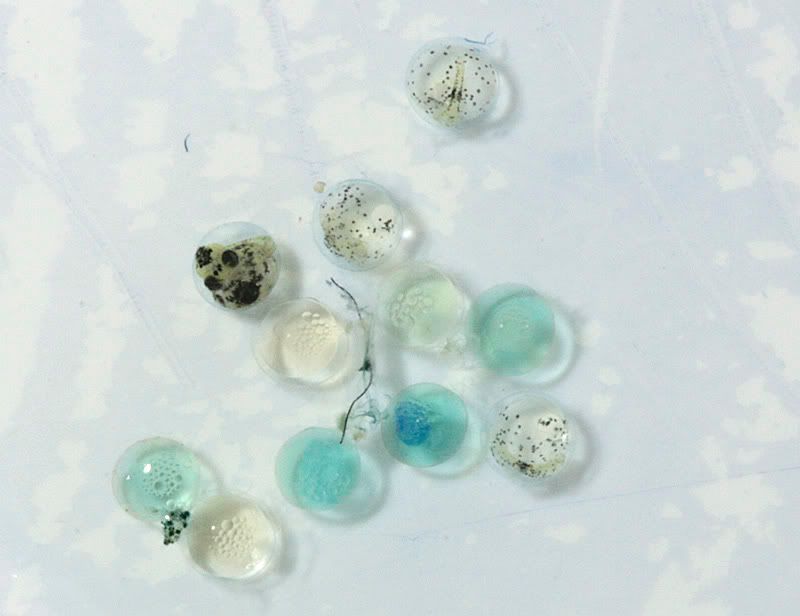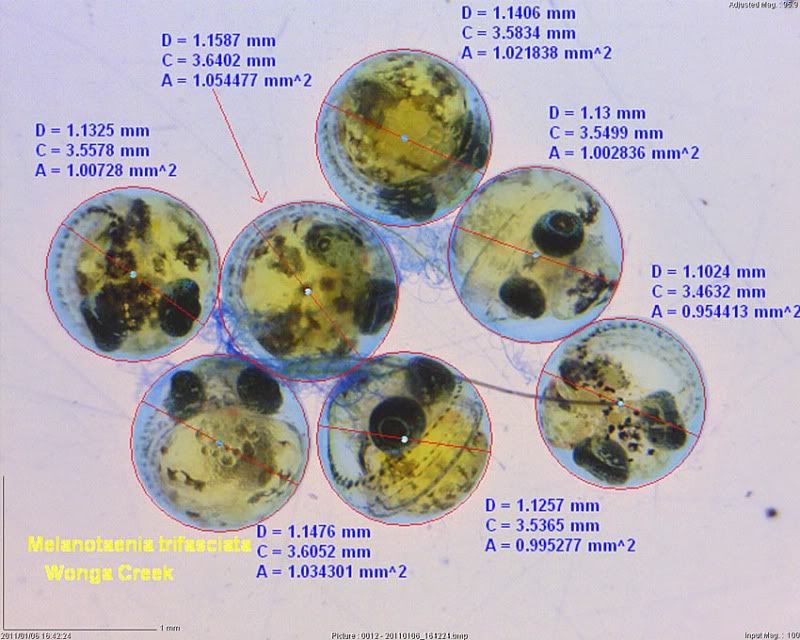Hatching Rainbowfish Eggs from Egg Kits
Feb 10, 2016 12:26:29 GMT -6
rainbowbratt, Mark~N, and 2 more like this
Post by rainbowfish on Feb 10, 2016 12:26:29 GMT -6
Hatching Rainbowfish Eggs - By Gary Lange
We should probably have a technique or a "how to" section because this will probably get lost in the grass eventually :-). This is a technique that I've perfected over many years. It enables members of the various clubs from all over the country to be able to hatch and raise my rainbowfish from the egg kits that I bring them. I tease that I can even get a "cichlid person" to successfully raise rainbowfish eggs to adult fish if they take the time to read and follow my instructions. It's not rocket science but like raising a lot of fish it is a little bit different. If you follow these instructions you'll get maximum hatch and optimal growth from your "bows". Unfortunately so many of the rainbowfish that are offered at the local pet store don't look anything like the originals. If you want the "good stuff" you have to seek out someone who keeps their rainbowfish uncrossed and pure like the original fish.
Typical Egg Kit – Contains Vial of eggs 40-60, 1 vial of micro-food, detailed instructions

Rainbowfish eggs are easy to hatch and the fry aren't too very difficult if you know the right tricks. Buying a mop or a vial of eggs at an auction is an easy way to obtain a whole aquarium full of these amazing fish. There's nothing more beautiful than a tank full of lacustris or boesemani rainbows. Before you get started… If you have obtained multiple vials of eggs. Hatch them separately and raise the fry separately. Different species grow at different rates and the big ones will eat the small ones! Make sure you write down the name of the species on the tank AND in your log somewhere in case you lose the label. There are lots of blue rainbows and yellow rainbows so asking me to ID by memory that yellow rainbow that you bought two years ago will not get you anywhere!
This is a method for hatching small amounts of eggs in shallow trays. You'll need a small shallow tray that holds about two to three cups of water. If your water is soft (< ~ 70 ppm GH) you'll need a little bit of crushed shell or coral to add to the hatching tray and perhaps a pinch of aquarium salt. Do not use acriflavine in the water. Add 1-2 cups of warm (80-82 degrees F) freshly dechlorinated water. Don't use aged tank water as it contains lots of bacteria and fungi, which can destroy your eggs. A higher hatching temperature promotes fungus & lower temperatures end up losing eggs. Too low of a temperature and the fungus might end up getting them again. It’s definitely a Goldilocks situation but with a heater in the tank it’s easy to get it “just right”. Carefully add the eggs to the tray, taking a few minutes to acclimate them, especially if the temperatures or water conditions are very different. Our St. Louis County water is 125 ppm GH and 2 degrees KH. I have removed all of the infertile eggs by soaking them overnight in a light solution of Methylene Blue. If the eggs are infertile they turn blue. Fertile eggs exclude the blue. You don't need to keep putting Methylene blue on your eggs, I just do it one time in the beginning to remove infertile ones.
Eggs of Pseudomugil furcata – eggs that are blue are infertile.

Eggs of Melanotaenia trifasciata location “Wonga Creek” with measurements

Eggs from Glossolepis wanamensis – they are much smaller than Pseudomugil eggs and the fry and much smaller. The light blue eggs are infertile

Separate them as much as possible with an eyedropper, toothpicks or fine point tweezers if they are clumped together. If one egg funguses, remove it before it spreads to another. Protect the tray from strong light. Make sure you keep it warm though, 80-82 F. You can float the tray in the aquarium that you are going to use for the hatched fry or place it in a warm spot in your fish room. A freshly prepared bare 5 or 10 gallon tank makes for a good raising tank. Just add a seasoned sponge filter and you’re set. Change the water in the tray at least once every other day. Large rainbowfish eggs take from 7-11 days to hatch from when they were laid. Pseudomugils (Blue-eyes) can take as long as 19-22 days. As soon as each fry hatches use an eyedropper or cup to transfer them. Then acclimate them to the fry-raising tank.
This is the type of sandwich tray that works quite nice. Float it in the tank that the fry are going to be in or incubate where the temperature will be 80-82 F.

Closeup of some more rainbowfish eggs. Eyed up ones ready to hatch, some in earlier development and some just laid and starting to develop.

Start feeding the fry small amounts of their first food immediately, they don’t have much of an egg yolk sac so if you wait, they will die! I like to use 2.5-5 gallon tanks for 12-50 fry. Be careful with the 2.5 gallon tank it is easy to lose water quality in a tank this small. If you have a lot of fry go to the 5-gallon size or even a 10-gallon. A ten is what I most often use if I'm hatching a large mop of eggs. It is important that the temperature of this fry-raising tank be at least 80 degrees F, preferably 82 degrees F. Water cooler than 78 degrees will result in a loss of most of the fry in a few days. I have raised fry in temperatures as high as 88 degrees F without any problems. Higher temperatures actually help them grow faster. Add a few snails and an established sponge filter to the fry tank. Bubble the sponge filter VERY SLOWLY! Rainbowfish fry live at the top 1/8-inch of the water for their first few days and they will soon drown in "the surf" that you produce by heavy aeration. For a first food you can use green water (say some), vinegar eels (great, but time consuming) or use what I use: Golden Pearls, 5-50 micron size. Sprinkle a little on the surface; don't mix it in the water. Feed twice a day, if possible more often. You can get it at Brine Shrimp Direct. In three to seven days they will be ready to eat newly hatched brine shrimp. Your goal is to get them to eat LIVE baby brine shrimp as soon as possible so they will thrive. Make sure all of the fish have orange bellies before you stop feeding the micro-food. Also remember that the eggs might have been produced on different days so some of the fry might be several days older than their siblings.
I also alternate other first foods with Golden Pearls or feed a powder mix including Chlorella powder, (health food store) spirulina, (not as good as Chlorella though) and Astaxanthin powder (NatuRose, BS direct), which really brings out the reds early in red colored fish. Remember for all of these powdered food; leave just a bit in the fish room as it does go bad. Keep the rest tightly sealed in the freezer. Go easy on the feedings but the snails should clean up the excess. If you feed too much siphon off the bottom debris. I usually like to wait about two weeks before I do the first water change (about 20%), which is then performed every 4-5 days. *** Make sure the water your add back is the same temperature as the fry are very temperature sensitive. Once they get about 6 weeks old I increase the percentage of water changed to 30%/week especially with a large hatch. For non-rainbows I would most likely be performing weekly 50% water changes. If you can remember to do smaller frequent water changes your bows will reward you with good growth. Rainbows certainly grow slower than most tropical fish but if you keep doing your water changes and keep them warm they will be producing their own eggs in 6-8 months. For hatching eggs in a mop I do basically the same thing except I add the mop directly to the rearing tank with fresh dechlorinated water. A slight amount of bubbling to avoid surface scum is all that is needed until they are hatched, and then you can add a sponge filter. Once the young juveniles reach about 1 to 1.25 inches in length I start backing off of the temperature, especially if I have raised them in the high eighties. Somewhere between 74 and 78 is fairly ideal for juveniles and most adults. Many of your adult rainbows will actually do better at even lower temperatures but most can thrive in temperatures anywhere between 70 and 80 degrees.
In Review:
1) Put the eggs in a tray, change the water at least every other day with fresh dechlorinated water.
2) As soon as a rainbowfish hatches move it to the raising tank (82-84 degrees)
3) Feed Golden Pearls 5-50 u immediately. Up to 10 days, depending on the species before they eat live BBS.
4) Change 20% of the water after 2 weeks, SAME TEMP or you will kill them!
5) More changes the better but keep them small with young fish.
6) Lower the temps and move to a bigger tank when they are ~1.5 inches.
With just a little work up front you can have an aquarium full of constantly moving color. There are still SO many new species of rainbowfish that haven’t even been discovered yet! So by all means do a little practicing so you can have a whole school of these magnificent creatures. There's always a new one just around the corner that will tickle your fancy.
Some places to talk about rainbowfishes here:
www.facebook.com/groups/rainbowfishaquarium/
